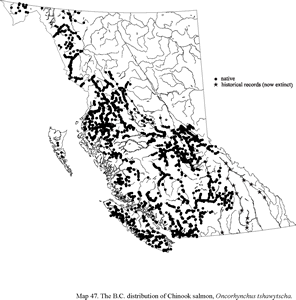Dorsal spines (total): 0; Dorsal soft rays (total): 10 - 14; Anal spines: 0; Anal soft rays: 13 - 19; Vertebrae: 67 - 75. Distinguished by the small black spots on the back and on the upper and lower lobes of the caudal fin, and the black gums of the lower jaw (Ref. 27547). Body fusiform, streamlined, noticeably laterally compressed in large adults, somewhat deeper than other species (Ref. 6885). Gill rakers wide-spaced and rough; pelvic fins with axillary process (Ref. 27547). Fish in the sea are dark greenish to blue black on top of head and back, silvery to white on the lower sides and belly; numerous small, dark spots along back and upper sides and on both lobes of caudal; gum line of lower jaw black (Ref. 27547). In fresh water, with the approach of the breeding condition, the fish change to olive brown, red or purplish, the color change being more marked in males than in females (Ref. 27547).
Chinook Salmon
Family: Salmonidae
Introduction
|
Species Information
Biology
|
Distribution
|
BC Distribution and Notes This is another genetically heterogeneous species and locally adapted populations are common. Apparently, much of the variation within the species is derived from the presence of two behavioural forms of Chinooks — a “stream type” and an “ocean type”. Stream type Chinooks have a relatively long period of freshwater residence (one or more years), at sea they make major offshore migrations, and they return to their natal rivers in the spring or summer. In contrast, ocean type Chinook usually migrate to sea within about three months of emergence, they spend most of their ocean life in inshore waters, and they return to their natal streams in the fall. From a biodiversity perspective, any management plans for this species should attempt to preserve a wide range of these life history variants. Source: Information provided by Don McPhail for E-Fauna BC. Global Distribution Arctic, Northwest to Northeast Pacific: drainages from Point Hope, Alaska to Ventura River, California, USA; occasionally strays south to San Diego in California, USA. Also in Honshu, Japan (Ref. 6793), Sea of Japan (Ref. 1998), Bering Sea (Ref. 2850) and Sea of Okhotsk (Ref. 1998). Found in Coppermine River in the Arctic. Several countries report adverse ecological impact after introduction. Source: FishBase. Page, L.M. and B.M. Burr 1991 A field guide to freshwater fishes of North America north of Mexico. Houghton Mifflin Company, Boston. 432 p. |
Status Information
|
BC Ministry of Environment: BC Species and Ecosystems Explorer--the authoritative source for conservation information in British Columbia. |
Additional Notes
|
